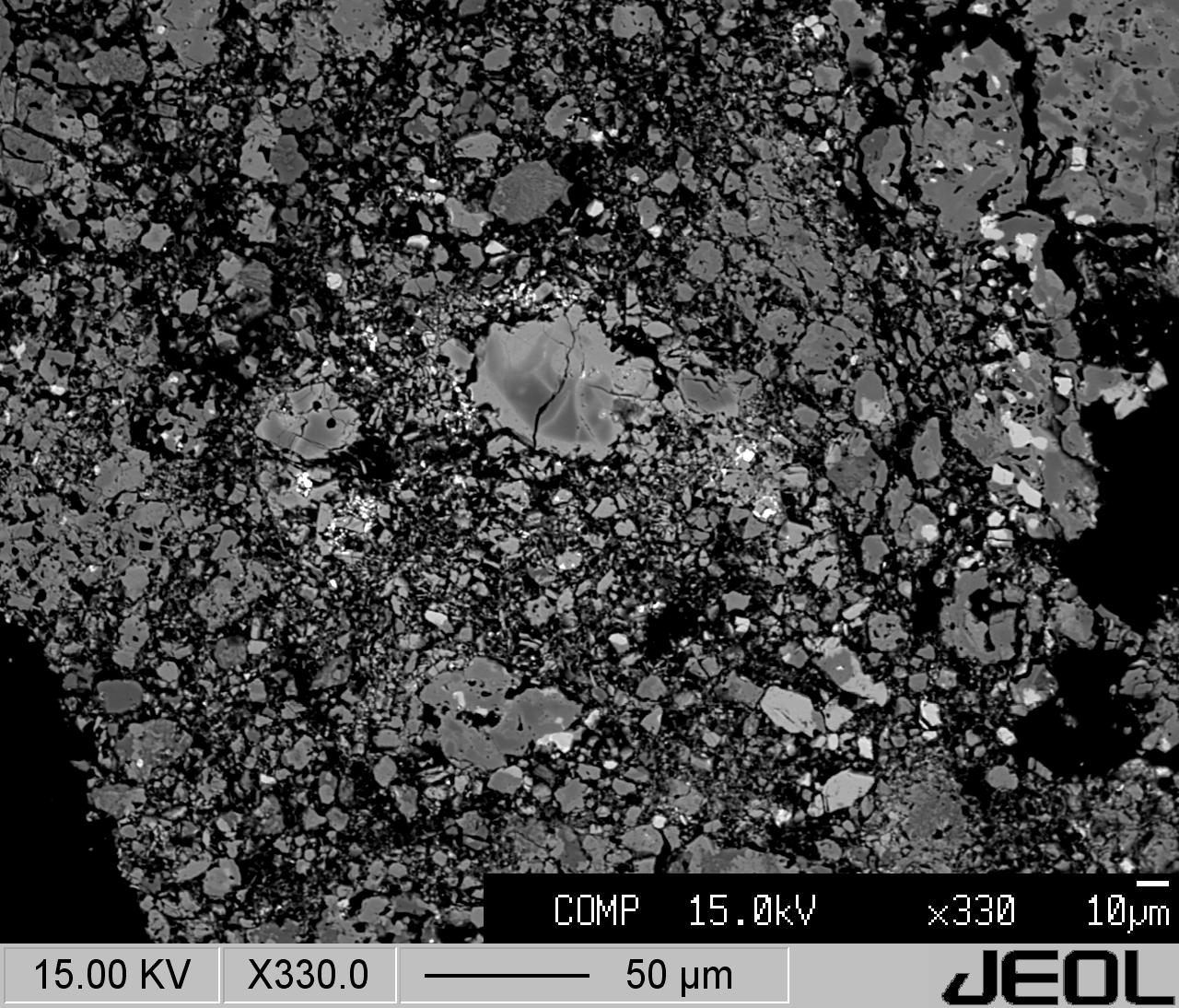About Me
After diploma studies in geology and mineralogy at the University of Cologne, Germany, a PhD in isotope cosmo- and geochemistry at the ETH Zurich, Switzerland and a postdoc/lab manager postion at the University of Chicago, I am currently on a Research Associate (Akademischer Rat) position at the University of Münster. My main (but not only) research interests are on the processes and timescales of the formation and evolution of the solar system and the Earth. When I am not in the lab, I enjoy being in the nature, riding boards, vegetarian cooking, and playing with my daughters.
Current projects
Accretion of moderately volatile elements and their behavior during core formation
Compared to primitive early solar system materials like comets or CI-chondrites, all planetary bodies in the inner solar system are depleted in (moderately) volatile elements. The timing and the processes responsible for this depletion are not well understood. Nebular fractonation during condensation as well as impacts most likely played a role. Using the stable isotope signatures of moderately volatile elements in meteorites and the Earth as well as carefully designed experiments we try to get a better handle on this issue.
Nucleosynthetic heritage and origin of Earth, Mars and the Moon
There is growing evidence that meteorites are not always good proxies for the bulk (isotopic) composition of the Earth and other inner solar system bodies. Using precise isotope measurements we are trying to figure out what the terrestrial planets are really made of and how their composition changed during accretion.
Isotope anomalies in planetary materials as tracers of mixing in the early solar system
While isotopic heterogeneity in bulk planetary bodies is well-established and often used as a tool to infer genetic relations of solar system objects, we also look at isotopic anomalies in meteoritic components (chondrules, matrix, CAIs) to constrain how these planetary materials formed and got mixed in the early solar nebula.
Origin of CAIs and their relation to chondrites
CAIs are considered to be the oldest surviving objects that formed in the solar nebula. They are found in primitive meteorites and often show enrichments in neutron-rich/r-process isotopes, suggesting that they formed from a nebular reservoir enriched in supernova material. CaIs are thus xenolithic objects that modify the isotopic composition of their host rocks. By isotope measurements and mass-balance calculations we to infere the impact of CAIs and other components on the generation of bulk planetary scale isotope anomalies. With these informations we ultimately try to reconstruct the earliest dynamical evolution of the solar accretion disk. This has implications for the accretion scenarios and genetic relationships of planets and asteroids.

2021
[36] Hellmann, J., Hopp, T., Burkhardt, C., Becker, H., Fischer-Gödde, M., Kleine, T. (2021): Tellurium isotope cosmochemistry: Implications for volatile fractionation in chondrite parent bodies and origin of the late veneer. Geochimica et Cosmochimica Acta, (accepted)
[35] Metzler, K., Hezel, D.C., Barosch, J., Wölfer, E., Schneider, J.M., Hellmann, J., Berndt, J., Stracke, A., Gattacceca, J., Greenwood, R.C., Franchi, I.A., Burkhardt, C., Kleine, T. (2021): The Loongana (CL) group of carbonaceous chondrites. Geochimica et Cosmochimica Acta 304, 1-31.
[34] Bischoff, A., Alexander, C.M.O'D., Barrat, J.-A. Burkhardt, C., and 37 others (2021): The old, unique C1 chondrite Flensburg - insight into the first processes of aqueous alteration, brecciation, and the diversity of water-bearing parent bodies and lithologies. Geochimica et Cosmochimica Acta, 293, 142-186.
2020
[33] Brennecka, G.A., Burkhardt, C., Budde, G., Kruijer, T.S., Nimmo, F., Kleine, T. (2020): Astronomical context of Solar System formation from molybdenum isotopes in meteorite inclusions. Science, 370, 837-840.
[32] Schneider, J.M., Burkhardt, C., Marrocci, Y., Brennecka, G.A., Kleine, T. (2020): Early evolution of the solar accretion disk inferred from Cr-Ti-O isotopes in individual chondrules. Earth and Planetary Science Letters, 551, 116585.
[31] Hellmann, J., Hopp, T., Burkhardt, C., Kleine, T. (2020): Origin of volatile element depletion among carbonaceous chondrites. Earth and Planetary Science Letters, 549, 116508.
[30] Spitzer, F., Burkhardt, C., Budde, G., Kruijer, T.S., Morbidelli, A., Kleine, T. (2020): Isotopic evolution of the inner Solar System inferred from molybdenum isotopes in meteorites. The Astrophysical Journal Letters, 898:L.
[29] Kleine, T., Budde, G., Burkhardt, C., Kruijer, T.S., Worsham, E.A., Morbidelli, A., Nimmo, F. (2020): The Non-carbonaceous-Carbonaceous Meteorite Dichotomy. Space Science Reviews 216, 55.
2019
[28] Bischoff, A., Barrat, J.-A., Berndt, J., Borovicka, J., Burkhardt, C., and 17 others (2019): The Renchen L5-6 chondrite breccia – The first confirmed meteorite fall from Baden-Württemberg (Germany). Geochemistry 79, 125525 .
[27] Burkhardt, C., Dauphas, N., Hans, U., Bourdon, B., Kleine, T. (2019): Elemental and isotopic variability in solar system materials by mixing and processing of primordial disk reservoirs. Geochimica et Cosmochimica Acta 261, 145-170.
[26] Worsham, E.A., Burkhardt, C., Budde, G., Fischer-Gödde, M., Kruijer, T.S., Kleine, T. (2019): Distinct evolution of the carbonaceous and non-carbonaceous reservoirs: Insights from Ru, Mo, and W isotopes. Earth and Planetary Science Letters 521, 103-112,
[25] Budde, G., Burkhardt, C., Kleine, T. (2019): Molybdenum isotopic evidence for the late accretion of outer Solar System material to Earth. Nature Astronomy, DOI: 10.1038/s41550-019-0779-y.
[24] Render, J., Ebert, S., Burkhardt, C., Kleine, T., Brennecka, G. A. (2019): Titanium isotopic evidence for a shared genetic heritage of refractory inclusions from different carbonaceous chondrites. Geochimica et Cosmochimica Acta, 254, 40-53.
2018
[23] Ebert, S., Render, J., Brennecka, G., Burkhardt, C., Bischoff, A., Gerber, S., Kleine, T. (2018): Ti isotopic evidence for a non-CAI refractory component in the inner Solar System. Earth and Planetary Science Letters 498, 275-265.
[22] Kleine, T., Budde, G., Hellman, J.L., Kruijer, T.S., Burkhardt, C. (2018): Tungsten Isotopes and the Origin of Chondrules and Chondrites. In: Chondrules (eds S.S. Russell, H.C. Connolly Jr., A.N. Krot), pp. 276-299. Cambridge University Press https://doi.org/10.1017/9781108284073.
2017
[21] Kruijer, T.S., Burkhardt, C., Budde, G., Kleine, T. (2017): Age of Jupiter inferred from the distinct genetics and formation times of meteorites. PNAS 114, 6712-6716.
[20] Bischoff, A., Barrat, J.-A., Bauer, K., Burkhardt, C., and 22 others (2017): The Stubenberg meteorite - an LL6 chondrite fragmental breccia recovered soon after precise prediction of the strewn field. Meteoritics and Planetary Science 52, 1683-1703. DOI:10.1111/maps.12883.
[19] Gerber, S., Burkhardt, C., Budde, G., Metzler, K., Kleine, T. (2017): Mixing and transport of dust in the early solar nebula as inferred from titanium isotope variations among chondrules. The Astrophysical Journal Letters, 841:L17 7pp.
[18] Render, J., Fischer-Gödde, M., Burkhardt, C., Kleine, T. (2017): The cosmic molybdenum-neodymium isotope correlation and the building material of the Earth. Geochemical Perspectives Letters 3, 170-178.
[17] Burkhardt, C., Dauphas, N., Tang, H., Fischer-Gödde, M., Qin, L., Chen, J.H., Rout, S.S., Pack, A., Heck, P.H., Papanastassiou, D.A. (2017): In search of the Earth-forming reservoir: Mineralogical, chemical and isotopic characterizations of the ungrouped achondrite NWA 5363/5400 and selected chondrites. Meteoritics and Planetary Science 52, 807-826. DOI:10.1111/maps.12834.
2016
[16] Budde, G., Burkhardt, C.,, Fischer-Gödde, M., Kruijer, T.S., Kleine, T. (2016): Molybdenum isotopic evidence for the origin of chondrules and a distinct genetic heritage of carbonaceous and non-carbonaceous meteorites. Earth and Planetary Science Letters 454, 293-303.
[15] Burkhardt, C., Borg, L.E., Brennecka, G.A., Shollenberger, Q.R., Dauphas, N., Kleine, T. (2016): A nucleosynthetic origin for the Earth's anomalous 142Nd composition. Nature 537, 394-398 DOI:10.1038/nature18956.
[14] Budde, G., Kleine, T., Kruijer, T.S., Burkhardt, C., Metzler, K. (2016): Tungsten isotopic constraints on the age and origin of chondrules. PNAS 113, 2886-2891.
2015
[13] Fischer-Gödde, M., Burkhardt, C., Kruijer, T., Kleine T. (2015): Ru isotope heterogeneity in the solar protoplanetary disk. Geochimica et Cosmochimica Acta 168, 151-171.
[12] Dauphas, N., Poitrasson, F., Burkhardt, C., Kobayashi, H., Kurosawa, K. (2015): Planetary and meteoritic Mg/Si and δ30Si variations inherited from solar nebula chemistry. Earth and Planetary Science Letters 427, 236-248.
[11] Burkhardt, C., Schönbächler, M. (2015): Intrinsic W nucleosynthetic isotope variations in carbonaceous chondrites: Implications for W nucleosynthesis and nebular vs. parent body processing of presolar materials. Geochimica et Cosmochimica Acta 165, 361-375.
2014
[10] Burkhardt, C. (2014): Isotopic composition of the Moon and the lunar isotopic crisis. In: Encyclopedia of Lunar Science, p. 1-13. B. Cudnik (Ed.) Springer International Publishing. ISBN 978-3-319-05546-6.
[9] Dauphas, N., Burkhardt, C., Warren, P.H., Teng, F.-Z. (2014): Geochemical arguments for an Earth-like Moon-forming impactor. Philosophical Transactions of the Royal Society A, 372:20130244.
[8] Kruijer, T.S., Kleine, T., Fischer-Gödde, M., Burkhardt, C., Wieler, R. (2014): Nucleosynthetic W isotope anomalies and the Hf-W chronometry of Ca-Al-rich inclusions. Earth and Planetary Science Letters 403, 317-327.
[7] Burkhardt, C., Hin, R.C., Kleine, T., Bourdon, B. (2014): Evidence for Mo isotope fractionation in the solar nebula and during planetary differentiation. Earth and Planetary Science Letters 391, 201-211.
2013
[6] Hin, R.C., Burkhardt, C., Schmidt, M.W., Bourdon, B., Kleine, T. (2013): Experimental evidence for Mo isotope fractionation between metal and silicate liquids. Earth and Planetary Science Letters 379, 38-48.
2012
[5] Burkhardt, C., Kleine, T., Dauphas, N., Wieler, R. (2012): Origin of isotopic heterogeneity in the solar nebula by thermal processing and mixing of nebular dust. Earth and Planetary Science Letters 357-358, 298-307.
[4] Kruijer, T.S., Sprung, P., Kleine, T., Leya, I., Burkhardt, C., Wieler, R. (2012): Hf-W chronometry of core formation in planetesimals inferred from weakly irradiated iron meteorites. Geochimica et Cosmochimica Acta 99, 287-304.
[3] Burkhardt, C., Kleine, T., Dauphas, N., Wieler, R. (2012): Nucleosynthetic tungsten isotope anomalies in acid leachates of the Murchison chondrite: Implications for hafnium-tungsten chronometry. The Astrophysical Journal Letters, 753:L6.
2011
[2] Burkhardt, C., Kleine, T., Oberli, F., Pack, A., Bourdon, B., Wieler, R. (2011): Molybdenum isotope anomalies in meteorites: Constraints on solar nebula evolution and origin of the Earth. Earth and Planetary Science Letters 312, 390-400.
2008
[1] Burkhardt, C., Kleine, T., Palme, H., Bourdon, B., Zipfel, J., Friedrich, J., Ebel, D. (2008) Hf-W mineral isochron for Ca,Al-rich inclusions: Age of the solar system and the timing of core formation in planetesimals. Geochimica et Cosmochimica Acta 72, 6177-6197.


